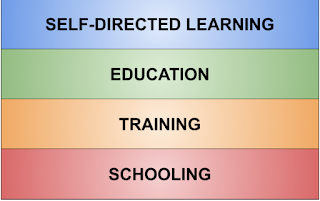Lateral Thinking

With all the concern about the pandemic this year, moving courses online and making plans for reopening, I'm afraid that what has been set aside is pedagogy. I did graduate work on a doctorate in pedagogy that I never completed, but it exposed me to a lot of ideas on how we might improve our teaching.
One of the things I learned about some decades ago is lateral thinking developed by Edward de Bono in the 1960s. Lateral thinking fosters unexpected solutions to problems. De Bono believed that we tend to go for the straightforward, and obvious solutions to problems. He encouraged seeking out more oblique, innovative answers.
Lateral thinking is sometimes called “horizontal thinking” as contrasted with vertical thinking. The latter might be defined as going for the first good solution that comes to mind and launch into the details.
Lateral thinking encourages a longer brainstorming session in order to enhance creativity and come up with the most innovative solutions.
There are several lateral thinking techniques: awareness, random stimulation, alternatives, and alteration.
For de Bono, we need to cultivate an awareness of how our minds process information. That is a skill that is very rarely part of any curriculum, and yet moving away from established patterns leads to greater innovation.
Random stimulation is something I have been employing during this pandemic year - and I suspect many readers of this have also - probably unconsciously - done it. Normally, we try to shut out all distractions in order to focus on a task. In lateral thinking, problem-solving improves with some "random" input which often includes information - taking a walk, talking with a colleague or stranger, listening to a podcast, journaling.
At the heart of de Bono's approach is to deliberately consider alternative solutions. That has been described is many ways, including "thinking out of the box." Doing this is not easy for many people. His term, "alteration," can mean using several techniques. You might reverse the relationship between parts of a problem. You might deliberately go in the opposite direction of what’s implied as the correct approach. Sometimes breaking a problem or obvious solution into smaller parts can lead to an alternate mindset about individual parts.
It didn't help the spread of de Bono's theories in academia that he was not a fan of extensive research. He had called research “artificial.” For example, he claimed that “nobody has been able to prove that literature, history or mathematics classes have prepared people for society” - though I think we all believe that they have helped prepare people.
Lateral thinking has its critics, but the basics are sound and I have always thought that incorporating them into classroom activities is a good thing. I have never "taught" de Bono to students, preferring to embed it in activities.
- https://www.edwddebono.com/lateral-thinking
- https://www.forbes.com/sites/phillewis1/2020/03/20/the-most-valuable-skill-in-difficult-times-is-lateral-thinking-heres-how-to-do-it/
- https://aeon.co/essays/lateral-thinking-is-classic-pseudoscience-derivative-and-untested
- https://www.opencolleges.edu.au/informed/features/cultivate-lateral-thinking/


